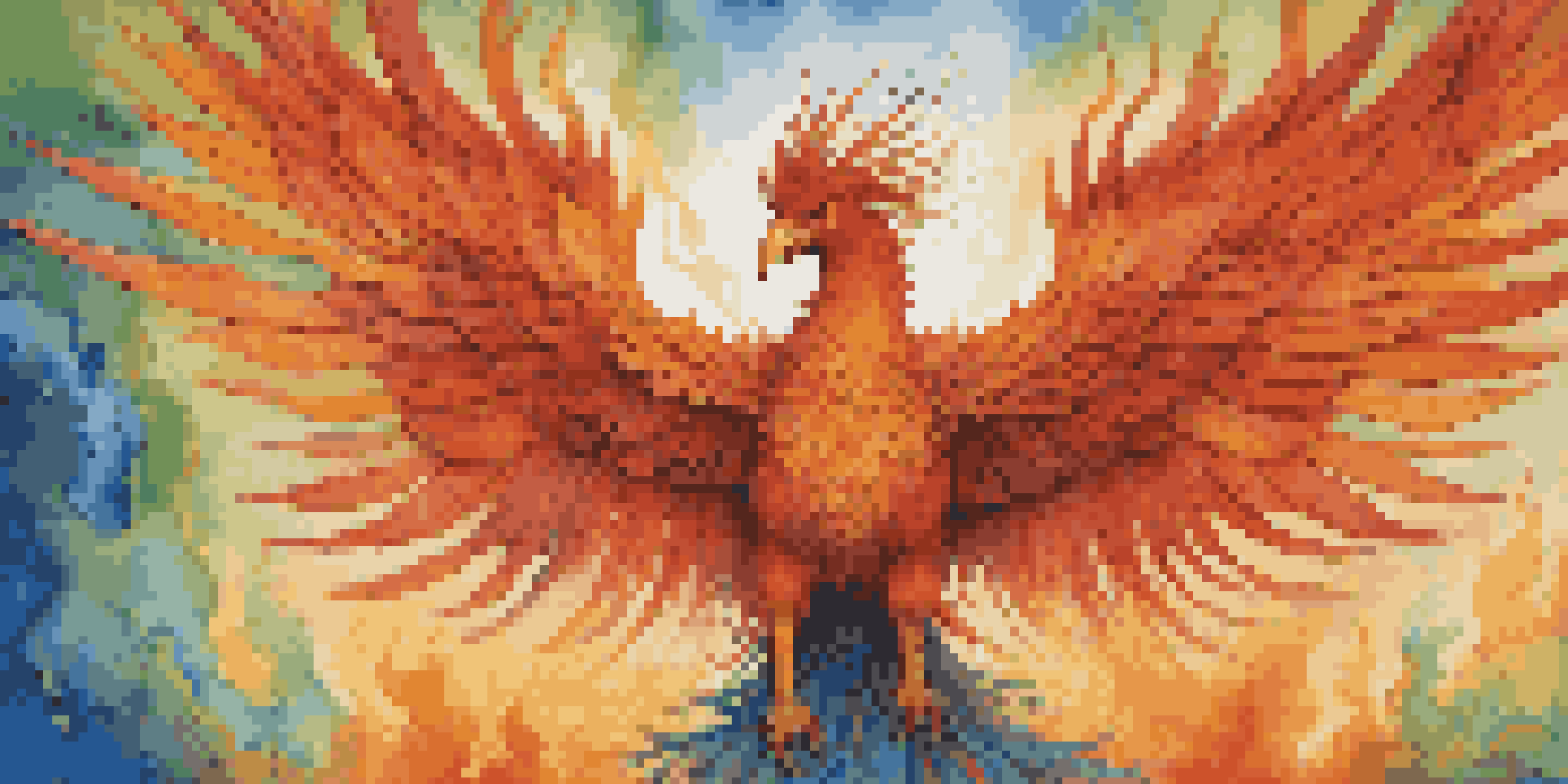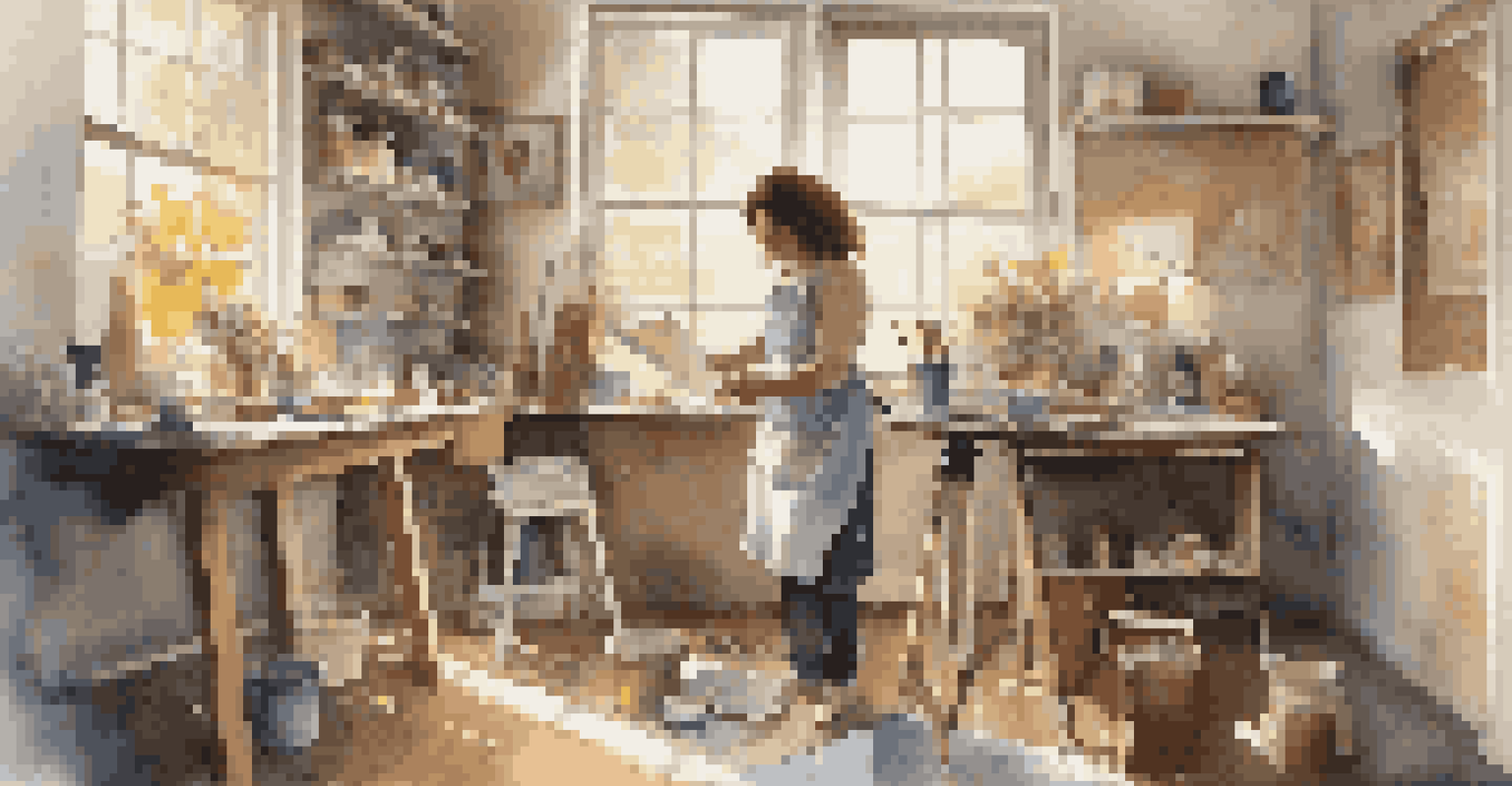Art, Memory, and Trauma: Cultural Responses Through Creativity

Understanding the Interplay of Art and Trauma
Art has long served as a powerful medium for expressing emotions, especially when it comes to trauma. It provides a unique outlet for individuals to process their experiences, often translating pain into beauty. Through various forms, such as painting, music, or dance, artists convey feelings that might be difficult to articulate in words.
Art is the most beautiful of all lies; it is the only way to express the inexpressible.
Trauma can leave lasting scars on both individuals and communities, impacting how they remember and interpret their past. Art captures this complexity, allowing both the creator and the viewer to engage in a shared experience of healing. For instance, a haunting melody might evoke memories of loss, while a vibrant mural could symbolize resilience.
By understanding this interplay, we can appreciate how art not only reflects trauma but also serves as a catalyst for conversation and healing. Engaging with art can facilitate discussions around difficult topics, promoting empathy and understanding in a world that often shies away from vulnerability.
Cultural Narratives and Collective Memory
Cultural narratives often shape our collective memory, particularly in the context of trauma. These narratives are reinforced through storytelling, art, and shared experiences, influencing how communities remember their histories. For example, traditional folk tales might recount historical events, embedding lessons within the fabric of a culture.

Artworks that emerge from collective trauma can serve as reminders of shared pain and resilience, creating a sense of unity among those affected. Consider the powerful impact of memorials or public art installations that commemorate tragic events; they honor those lost while encouraging reflection and dialogue within the community.
Art Transforms Trauma into Healing
Art serves as a powerful medium for individuals to express and process trauma, fostering healing and empathy.
By engaging with these cultural narratives, we not only preserve memory but also ensure that the lessons learned from traumatic experiences are not forgotten. This process of remembrance through art fosters a deeper understanding of our shared humanity and the complexities of our histories.
The Role of Personal Expression in Healing
Personal expression through art can be a transformative tool for healing. When individuals create art in response to trauma, they often find a sense of agency and empowerment amid their pain. For example, writing poetry or painting can become a way for someone to reclaim their narrative and express emotions that may otherwise feel overwhelming.
The role of the artist is to ask questions, not to answer them.
Art allows for exploration of personal identity, helping individuals to process their experiences in a safe space. Through this creative journey, they can confront their trauma, articulate their feelings, and ultimately foster a sense of hope. The act of creating becomes a therapeutic outlet, promoting emotional resilience.
Moreover, sharing these personal expressions with others can build connections, facilitating a sense of community among those who have experienced similar traumas. This collective sharing not only normalizes the conversation around trauma but also encourages mutual support and understanding.
Art as a Reflection of Societal Trauma
Art often serves as a mirror reflecting the societal trauma experienced by communities. Various artistic movements have arisen in response to social injustices, conflicts, or crises, providing a voice to the marginalized. For instance, the works of artists during the Civil Rights Movement vividly captured the struggle for equality, igniting conversations that continue today.
In this way, art becomes a powerful tool for advocacy, challenging societal norms and calling for change. Through powerful imagery, evocative performances, or poignant literature, artists can shine a light on painful realities, prompting society to confront uncomfortable truths. This engagement with trauma through art can pave the way for healing and transformation.
Cultural Narratives Shape Memory
Cultural narratives and collective memory, reinforced through art, help communities remember shared traumas and lessons learned.
Additionally, as audiences interact with these artworks, they gain insight into the lived experiences of others, fostering empathy and understanding. This connection between artist and audience reinforces the idea that art can play a crucial role in societal healing and collective progress.
The Healing Power of Community Art Projects
Community art projects offer a collaborative approach to addressing trauma, allowing individuals to come together in a shared creative process. These initiatives can range from mural projects to theater performances, all designed to engage communities in meaningful dialogue about their experiences. By co-creating, participants cultivate a sense of belonging and collective healing.
Such projects often serve as safe spaces for individuals to express their emotions and share their stories. The collaborative nature fosters connections, as participants realize they are not alone in their struggles. For example, a community mural depicting resilience can symbolize hope and strength, transforming a space while also healing its creators.
Furthermore, these projects often attract wider community interest, encouraging discussions around trauma and resilience. By engaging the public in the creative process, community art projects can challenge societal stigma and promote understanding, reinforcing the idea that healing is a communal journey.
Digital Art: New Frontiers in Trauma Expression
The rise of digital art has opened new avenues for individuals to explore and express trauma. With the accessibility of technology, artists can create and share their work with a global audience, breaking geographical barriers. Digital platforms allow for innovative expressions, from virtual reality experiences to interactive installations that invite viewers to engage with trauma in novel ways.
This medium provides artists with the tools to push boundaries and experiment with forms of expression that resonate with their experiences. For instance, using animation to depict personal narratives can provide a unique perspective on trauma, allowing for a deeper emotional connection with the audience. The online space also enables conversations that might not occur in traditional settings.
Community Projects Foster Connection
Community art projects create spaces for collective healing, allowing individuals to share their experiences and build connections.
Moreover, the anonymity of digital platforms can empower individuals to share their stories without fear of judgment. This inclusive aspect fosters a diverse range of voices, enriching the discourse around trauma and healing. By embracing digital art, we can expand our understanding of how creativity and technology intersect in addressing complex human experiences.
Looking Ahead: The Future of Art and Trauma Discourse
As we look to the future, the relationship between art and trauma will likely continue to evolve. With increasing recognition of mental health issues and the importance of processing trauma, artistic expression will remain a crucial avenue for dialogue and healing. Artists will increasingly leverage new technologies and platforms to share their narratives, ensuring diverse voices are heard.
The growing emphasis on inclusivity and representation in the arts will also shape how we understand and respond to trauma. By highlighting marginalized perspectives, we can foster a richer discourse that encompasses a variety of experiences and insights. This shift may lead to more collaborative and interdisciplinary approaches to addressing trauma through art.

Ultimately, the ongoing exploration of art, memory, and trauma will serve as a testament to the resilience of the human spirit. By continuing to engage with these themes, we can not only honor our past but also pave the way for a more empathetic and connected future.